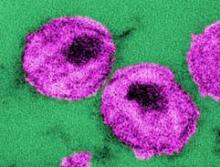ATLANTA – A substantial proportion of patients who tested positive for HIV infection in urban emergency departments had not been tested elsewhere, according to a retrospective study of patient records.
The findings suggest that EDs are an ideal venue for identifying new infections and linking patients to appropriate care, Hilda Ndirangu of the Baltimore City Health Department reported in a poster at a conference on STD prevention sponsored by the Centers for Disease Control and Prevention.
HIV testing in EDs not only helps identify new infections and link patients to care, but also helps re-link previously diagnosed patients to care for better HIV continuum of care outcomes, and can reduce HIV-related disparities, Ms. Ndirangu noted.
Of 27,816 patients tested in Baltimore area EDs between July 2012 and December 2013, 118 had a confirmed positive HIV test, and 68 of the tests were "new positives," while 50 were in patients who had previously tested HIV positive. Of the patients with new positives, 44 (65%) had not been tested at any other publicly funded testing site in the department’s database, Ms. Ndirangu said.
"These findings give merit to the utility of ED testing programs in finding acute HIV positive cases and those who are vulnerable to being infected with HIV," Ms. Ndirangu said.
The Baltimore City Health Department initiated routine HIV testing in EDs in 2008. Since then, more than 93,000 patients have been tested. Of those tests, 493 were positive, and 355 were new positives. Of the new positives, 241 (68%) were linked to care.
The study involved a review of the records of all HIV-positive cases during the study period, and a search of electronic databases to determine whether the patients had ever been tested at any of the publicly funded programs that report HIV testing activities to the Baltimore City Health Department.
HIV remains a major public health problem that disproportionately affects the urban poor, who often use EDs for primary care. The findings, though limited by small sample size, incomplete reporting of negative tests, and the likelihood that some patients with positive tests had been tested somewhere other than at publicly funded test sites in the study area, suggest that HIV testing in EDs reaches patients who do not perceive themselves to be at risk and who thus do not seek testing elsewhere, Ms. Ndirangu said.
"Despite the declining new positivity rates (1.05% in 2008, 0.5% in 2009, 0.5% in 2010, 0.3% in 2011, 0.25% in 2012) Baltimore EDs still surpass the cost-effectiveness threshold of 0.1% for undiagnosed rate that warrants routine testing," she wrote. In Baltimore, the HIV incidence remains high at 81.4/100,000.
Ms. Ndirangu reported having no disclosures.

